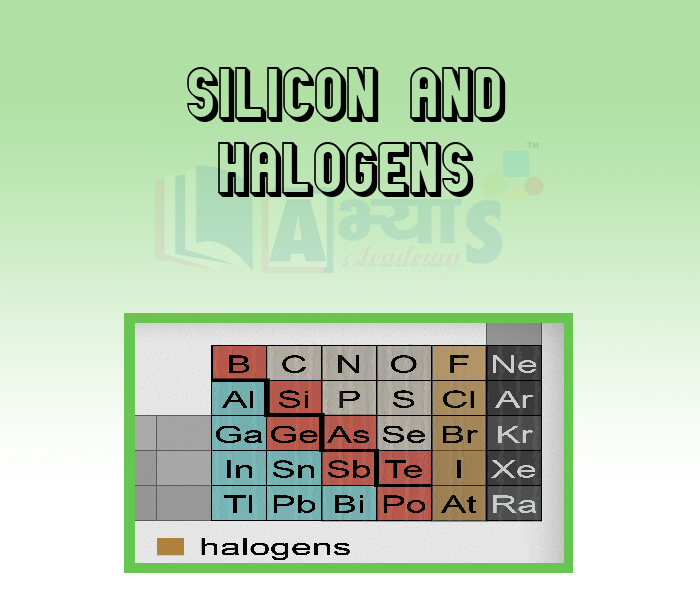Silicon And Halogens


Silicon And Halogens
Silicon: Silicon is the second most abundant element on earth after oxygen. Silicon dioxide, also known as silica, occurs as quartz, which is a crystalline solid, and in an impure form as sand and sandstone. Silica is a transparent mineral made up of silicate sheets. Silicon is a hard shiny grey solid with a high melting point Its structure is similar to that of diamond, Silicon is a semiconductor. It is one of the few elements which show the general characteristic of both metals and non-metals.
Silicon is used in making microprocessors or silicon chips. A microprocessor is made up of many thousands of transistors arranged on a single chip of silicon.
Glass is made by heating silicon dioxide in the form of sand with sodium carbonate and calcium carbonate to a temperature of about I500°C.
Halogens:The halogen family consists of the elements fluorine, F; chlorine, Cl; bromine, Dr, iodine, I; and astatine, At. All the halogen elements, except astatine, exist in the earth's crust and atmosphere.
The halogens are the best-defined family of elements. They have an almost perfect gradation of physical properties. Fluorine is pale yellow; chlorine is yellow green; bromine is dark brown; and iodine is deep violet. Although all halogens generally undergo the same types of reactions, the extent and ease with which these reactions occur vary markedly. Fluorine, in particular, has the usual tendency of the lightest member of a family of elements of exhibiting reactions not comparable to the other members.
Bromine and its compounds are used as disinfection and sanitising agents in swimming pools and potable water. Bromine chemicals are used as intermediates in manufacturing organic dyes, in storage batteries and fire extinguishing systems.
Chlorine is used for purifying water. As a chemical compound, both organic and inorganic, chlorine has many uses. Some useful compounds are sodium chloride, calcium chloride, chloroform, methyl chloride, chlorobenzene, etc.
Students / Parents Reviews [10]
One of the best institutes to develope a child interest in studies.Provides SST and English knowledge also unlike other institutes. Teachers are co operative and friendly online tests andPPT develope practical knowledge also.

Aman Kumar Shrivastava
10thMy experience was very good with Abhyas academy. I am studying here from 6th class and I am satisfied by its results in my life. I improved a lot here ahead of school syllabus.

Ayan Ghosh
8thBeing a parent, I saw my daughter improvement in her studies by seeing a good result in all day to day compititive exam TMO, NSO, IEO etc and as well as studies. I have got a fruitful result from my daughter.

Prisha Gupta
8thAbhyas Methodology is very good. It is based on according to student and each child manages accordingly to its properly. Methodology has improved the abilities of students to shine them in future.

Manish Kumar
10thAbout Abhyas metholodology the teachers are very nice and hardworking toward students.The Centre Head Mrs Anu Sethi is also a brilliant teacher.Abhyas has taught me how to overcome problems and has always taken my doubts and suppoeted me.

Shreya Shrivastava
8thIt has a great methodology. Students here can get analysis to their test quickly.We can learn easily through PPTs and the testing methods are good. We know that where we have to practice

Barkha Arora
10thMy experience with Abhyas is very good. I have learnt many things here like vedic maths and reasoning also. Teachers here first take our doubts and then there are assignments to verify our weak points.

Shivam Rana
7thA marvelous experience with Abhyas. I am glad to share that my ward has achieved more than enough at the Ambala ABHYAS centre. Years have passed on and more and more he has gained. May the centre flourish and develop day by day by the grace of God.

Archit Segal
7thAbhyas is a complete education Institute. Here extreme care is taken by teacher with the help of regular exam. Extra classes also conducted by the institute, if the student is weak.

Om Umang
10thMy experience with Abhyas academy is very good. I did not think that my every subject coming here will be so strong. The main thing is that the online tests had made me learn here more things.
